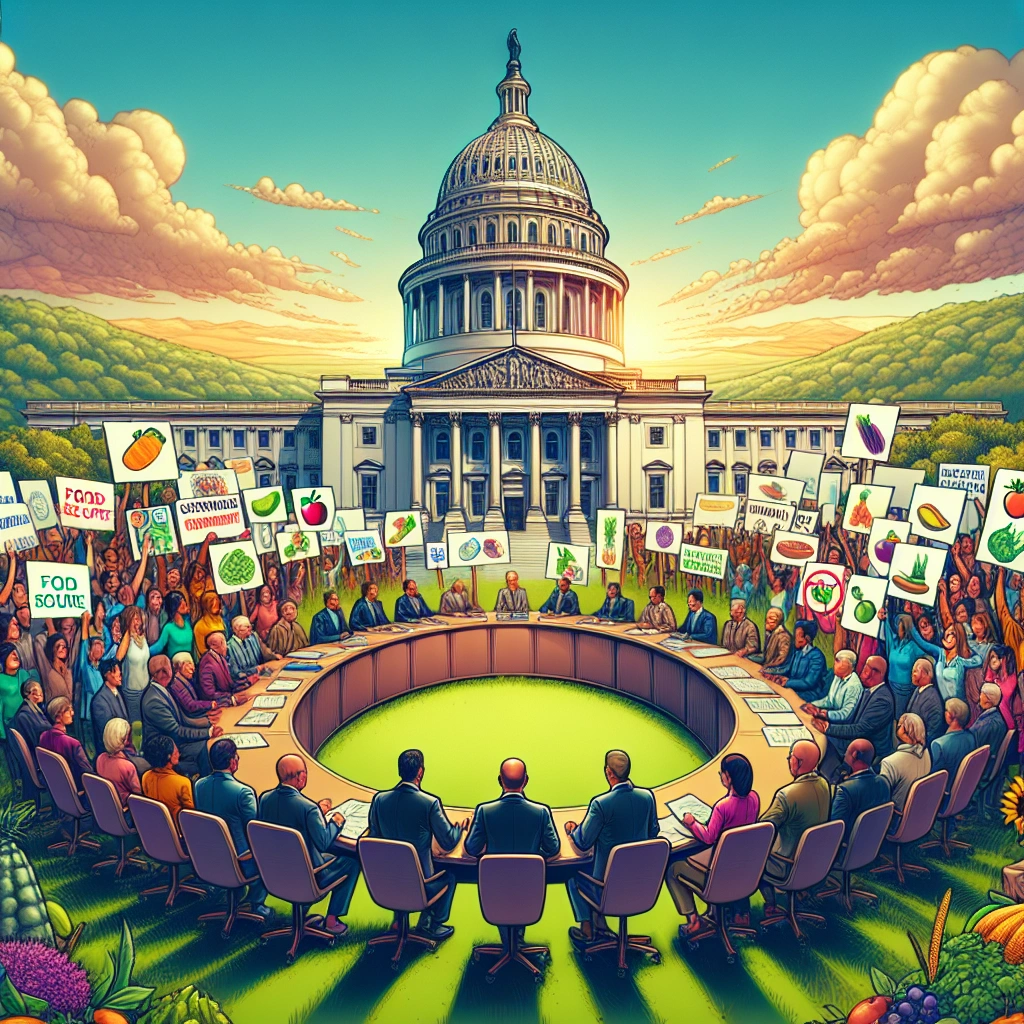

Advocacy groups influence policy change for food security and consumer by lobbying for laws and regulations that promote food safety, security, and consumer rights.
They also play a crucial role in raising awareness about the importance of food security and consumer protection, influencing public opinion, and ultimately shaping government policies.
Additionally, advocacy groups provide expertise and work closely with policymakers to develop and implement effective food security and consumer policies.
The Need for Policy Change in Food Security and Consumer
Advocacy groups play a crucial role in influencing policy change for food security and consumer rights. By raising awareness about key issues and championing the needs of consumers, these groups apply pressure on policymakers to prioritize food safety and security.
Their campaigns, lobbying efforts, and public outreach serve to highlight the importance of stringent regulations and effective policies to ensure the well-being of consumers and the security of the food supply chain. The influence of advocacy groups can lead to the implementation of new policies that address emerging challenges in food security and consumer protection.
Current challenges in food security and consumer protection
Currently, the food industry faces significant challenges in ensuring food security and consumer protection. These challenges include the rise of new and emerging bacteria, toxins, and antimicrobial resistance, which threaten the safety of the food supply.
Additionally, changes in consumer preferences and habits, as well as environmental factors, contribute to food contamination and safety concerns. These challenges require proactive measures to safeguard the interests of consumers and maintain high food safety standards.
Impact of existing policies on food security and consumer rights
Existing policies have a direct impact on food security and consumer rights. Regulations governing food production, supply, safety, and nutritional information influence consumer choices and the overall quality of their diets.
These policies also affect the accessibility and affordability of nutritious food, especially for vulnerable populations. Furthermore, ethical frameworks and principles can inform the development of just food policies that prioritize the well-being of consumers.
It is imperative for existing policies to adapt to evolving challenges and address the changing landscape of food security and consumer protection.
| Food Security Challenges | Impact of Existing Policies |
|---|---|
| New and emerging bacteria, toxins, and antimicrobial resistance | Influence consumer choices and dietary quality |
| Changes in consumer preferences and habits | Accessibility and affordability of nutritious food |
| Environmental changes leading to food contamination | Ethical frameworks for just food policies |
This table illustrates the correlation between food security challenges and the impact of existing policies on consumer rights, emphasizing the need for policy change to address these critical issues effectively.
Historical Impact of Advocacy Groups on Policy Change
Throughout history, advocacy groups have played a pivotal role in driving successful policy changes, particularly in the realm of food security and consumer rights. These groups have utilized strategic advocacy efforts to bring about tangible and impactful transformations in policy landscapes.
Examples of successful policy changes driven by advocacy groups
One notable example is the advocacy efforts of organizations like Food & Water Watch, which successfully campaigned for the implementation of regulations to reduce the use of harmful pesticides in food production. Their persistent advocacy led to the enactment of stricter regulations, safeguarding consumer health and promoting sustainable agricultural practices.
Another compelling instance is the advocacy work of the Environmental Working Group, which championed for clearer labeling of GMO products. Their dedicated advocacy efforts prompted policymakers to introduce clearer labeling requirements, empowering consumers to make informed choices about the food they consume.
Role of influential advocacy groups in shaping policy decisions
Influential advocacy groups have significantly shaped policy decisions by leveraging their expertise, resources, and public support to influence lawmakers and regulatory bodies. The impactful role of these advocacy groups is evident in their ability to drive meaningful changes in food safety standards, nutrition labeling, and access to healthy, affordable food options.
| Advocacy Groups | Key Policy Influence | Resulting Impact |
|---|---|---|
| Food & Water Watch | Pesticide Regulations | Improved Food Safety |
| Environmental Working Group | GMO Labeling Requirements | Consumer Empowerment |
Advocacy groups have left an indelible mark on policy change, serving as catalysts for positive transformations in food security and consumer rights. Their unwavering commitment to advocating for impactful reforms continues to shape a brighter and healthier future for communities worldwide.
The Strategies Employed by Advocacy Groups
Lobbying efforts and their impact
– Advocacy groups heavily rely on lobbying to influence policymakers by providing valuable information and insights related to food security and consumer rights.
– They strategically engage with legislators to sway policy decisions in favor of initiatives promoting food security and consumer protection.
Grassroots mobilization and community engagement initiatives
– Advocacy groups leverage grassroots mobilization and community engagement initiatives to create substantial public support for their cause.
– By organizing local events, engaging with local media, and collaborating with community partners, advocacy groups amplify their message and mobilize communities to address food security and consumer issues effectively.
Influence on Legislation and Regulation
Advocacy group involvement in drafting and passing legislation
Advocacy groups play a crucial role in the drafting and passing of legislation related to food security and consumer rights. Through lobbying efforts and engagement with lawmakers, these groups advocate for policies that prioritize the well-being of consumers and ensure food security for all.
For example, organizations like the Center for Science in the Public Interest have been instrumental in pushing for legislation such as the Nutrition Labeling and Education Act, which has had a significant impact on consumer awareness and food product labeling.
Impact of advocacy efforts on regulatory decisions
The impact of advocacy efforts on regulatory decisions is profound, as these groups provide valuable insights and data-driven recommendations to regulatory bodies. By leveraging expert opinions and research, advocacy groups influence the development of regulations that safeguard consumer interests and enhance food security.
An exemplary case is the advocacy by organizations like Food & Water Watch in driving regulatory decisions that prioritize food safety standards and sustainable agricultural practices, benefiting both consumers and the environment.
| Advocacy Group | Legislative Impact |
|---|---|
| Center for Science | Nutrition Labeling and Education Act |
| Food & Water Watch | Food safety standards and sustainable agricultural practices |
The Role of Advocacy Groups in Public Awareness
Consumer education initiatives
- Advocacy groups play a pivotal role in consumer education initiatives by providing valuable resources and programs that equip consumers with the knowledge and tools to make informed choices in the marketplace.
- Through initiatives like the National Consumers League’s LifeSmarts program, consumers are empowered to navigate the marketplace with confidence, fostering a culture of informed decision-making and consumer empowerment.
- Consumer education initiatives act as a catalyst for driving individual behavior change, reinforcing enforcement of laws, and fostering effective citizen participation in the marketplace.
Promoting sustainable food security practices
- Advocacy groups collaborate with stakeholders like farmers, retailers, and governments to promote sustainable food security practices through public awareness campaigns.
- These campaigns create opportunities for individuals to make informed choices, support local farmers, and contribute to resilient and sustainable local agricultural economies.
- By advocating for policies that support sustainable agriculture, fair trade practices, and conservation of natural resources, advocacy groups play a crucial role in promoting sustainable food security practices.
| Advocacy Groups | Consumer Education Initiatives |
|---|---|
| National Consumers League | LifeSmarts program |
| WFP (World Food Programme) | Public awareness campaigns |
| Farmer advocacy groups | Community-based interventions |
Your published article sounds so informative and engaging. It is so unique that it might get you a deal to write for a famous blog that specializes in topics regarding Consumer Education Initiatives and Promoting Sustainable Food Security Practices.
Keep up the good work!
Collaboration with Government Bodies
Advocacy groups play a crucial role in influencing policy change for food security and consumer welfare. Through partnerships with policymakers, these groups bring about effective change in regulations and legislations that impact the access to nutritious food and consumer protection.
By engaging in direct lobbying, disseminating information, and mobilizing communities, advocacy groups work towards shaping public opinion and driving governmental decisions. One case study that exemplifies successful collaboration between advocacy groups and the government is the Health Impact Project, where cross-sector efforts reduced health disparities in maternal and infant health in multiple states.
This underlines the power of collaborative advocacy in driving positive change for the community.
| Advocacy Groups and Government Collaboration | |
|---|---|
| Advocacy Groups | Government Bodies |
| – Direct lobbying | – Shaping regulations and policies |
| – Mobilizing communities | – Implementing consumer protection |
| – Disseminating information | – Addressing food security |
| – Engaging in successful partnerships | – Facilitating health equity initiatives |
Effective partnerships between advocacy groups and government bodies are essential for advancing health equity, creating shared visions, and fostering multi-sector collaboration. These partnerships ensure that the voices of the community are heard and integrated into policymaking, leading to impactful changes in the food security landscape and consumer welfare.
Addressing Food Insecurity and Consumer Rights
Action plans for improving food access and affordability
Advocacy groups play a crucial role in influencing policy change to improve food access and affordability by lobbying for government funding for food assistance programs, pushing for legislation to address food deserts and supporting initiatives to increase access to nutritious food in underserved communities. Take, for instance, the Healthy Food Financing Initiative, a program advocated by various groups that aims to bring grocery stores and other healthy food retailers to underserved urban and rural communities.
Ensuring consumer protection and fair trade practices
Advocacy groups influence policy change to ensure consumer protection and fair trade practices by advocating for transparent food labeling, supporting stricter regulations on food safety and quality, and pushing for fair trade policies that protect small-scale farmers and promote sustainable agricultural practices. For example, the Fair Trade Certified label, backed by advocacy groups, ensures that agricultural workers receive fair wages and work in safe conditions, thus protecting consumers and promoting ethical food production practices.
Measuring Impact and Success
Metrics for evaluating the effectiveness of advocacy efforts
To gauge the impact of advocacy efforts, metrics like the number of policy changes influenced, lives touched, and public awareness raised are crucial. Additionally, tracking the level of engagement on social media, the number of signatures collected, and media mentions can provide a comprehensive view of the effectiveness of advocacy campaigns.
These metrics help quantify the reach and relevance of advocacy initiatives, shedding light on their tangible outcomes.
Case studies demonstrating tangible policy change resulting from advocacy work
Case studies serve as powerful exemplars of advocacy impact on policy change. For instance, the PATH organization’s successful advocacy efforts influenced decision-makers, resulting in notable policy modifications supporting global health.
Similarly, the WGF Board’s direct involvement in policy advocacy led to significant shifts, showcasing the influential impact of advocacy groups in driving tangible policy alterations. These cases vividly illustrate how advocacy initiatives can yield substantial changes in policies affecting food security and consumer well-being.
The Role of Technology in Advocacy Efforts
Utilizing digital platforms for awareness and mobilization
Digital platforms play a pivotal role in advocating for policy change in food security and consumer welfare. Advocacy groups leverage social media, email, and mobile optimization to raise awareness and mobilize supporters.
For instance, through social media advocacy strategies, they share action alerts to galvanize individuals towards influencing public policy. This digital shift has expanded the outreach capacity, enabling advocacy groups to engage a wider audience and drive collective action for impactful change.
Tools for data-driven advocacy and policy research
In the realm of data-driven advocacy and policy research, technology empowers advocacy groups to access and analyze crucial information for informed decision-making. Cutting-edge AI technologies, such as CiviClick’s stakeholder mobilization platform, facilitate the generation of compelling email content for action alerts, enhancing conversion rates and contributing to successful policy outcomes.
Additionally, the use of digital tools like social media, online communities, and advocacy software enables these groups to effectively engage supporters, mobilize individuals for essential actions, and influence target audiences, ultimately driving policy change.
Overcoming Challenges and Criticisms
Addressing counterarguments to advocacy group influence
It’s crucial to address counterarguments when advocating for policy change. By acknowledging opposing viewpoints and understanding the concerns of stakeholders, advocacy groups can tailor their messaging to resonate with a wider audience.
For example, when promoting food security policies, addressing concerns about cost implications and potential disruptions to existing systems can help build consensus and mitigate opposition.
Handling pushback and resistance from stakeholders
When faced with pushback and resistance from stakeholders, communication and empathy are key. Understanding the perspectives and priorities of stakeholders allows advocacy groups to engage in meaningful dialogue and address objections effectively.
For instance, actively listening to stakeholders’ concerns and demonstrating how proposed policy changes align with their values can help alleviate resistance and build support for the advocated changes.
| Stakeholder Management Strategies |
|---|
| 1. Active Listening and Empathy |
| 2. Tailoring Messaging to Address Concerns |
| 3. Building Consensus through Dialogue |
Overcoming challenges and criticisms in advocating for policy change requires strategic communication, empathy, and a willingness to address opposing viewpoints with clarity and understanding. By engaging stakeholders in meaningful discussions and addressing their concerns, advocacy groups can navigate resistance and drive positive policy change for food security and consumer interests.
Global Impact and Cross-Border Collaboration
In the realm of international food security initiatives, advocacy groups play a crucial role in influencing policy changes. Through their cross-border collaborations, these groups work tirelessly to address key issues related to food security and consumer welfare on a global scale.
By leveraging their collective voice and expertise, these advocacy efforts contribute to shaping policies that have far-reaching impacts on addressing hunger, malnutrition, and poverty across different countries and regions.
Advocacy efforts in international food security initiatives
Advocacy groups engage in various strategic initiatives to advocate for international food security. They actively participate in high-level discussions, policy forums, and global summits to raise awareness and push for policy changes that prioritize food security and nutrition.
For instance, organizations like the World Food Programme (WFP) and Project Concern International (PCI) collaborate with governments, UN bodies, and other stakeholders to influence policies that combat hunger worldwide and enhance health on a global scale.
Examples of successful global policy influence by advocacy groups
Notably, advocacy groups have demonstrated significant success in influencing global policy changes for food security. The World Bank’s initiatives, such as the West Africa Food Systems Resilience Program, supported by $45 billion in funding, have benefited millions of people in 90 countries, showcasing the tangible impact of advocacy efforts.
Moreover, organizations like the Agriculture Justice Project (AJP) and the Alliance for Food Sovereignty in Africa have successfully advocated for policies that champion family farming, indigenous knowledge, and fair practices in the agriculture system, contributing to global food security measures.
Ensuring Inclusivity in Advocacy Efforts
Addressing diversity and equity within advocacy groups
To ensure diversity and equity within advocacy groups, it’s crucial to prioritize the identification of strategic priorities that promote diversity, equity, and inclusion (DEI). Conducting regular pay equity reviews, recruiting and promoting individuals from diverse perspectives, and creating robust training programs are essential steps toward fostering an inclusive environment within advocacy groups.
By actively managing unconscious bias and communicating the significance of addressing bias, advocacy groups can promote a more inclusive and equitable workplace.
Ensuring representation of marginalized communities in policy discussions
Advocacy groups can ensure the representation of marginalized communities in policy discussions by actively practicing daily actionable strategies to build diverse advocacy teams. Additionally, it’s vital for advocates and organizations to carry out advocacy practices that work toward equity and social justice, empowering underrepresented groups.
Meaningful engagement of marginalized communities can be achieved through inclusive action plans, such as engaging in facilitated discussions, surveys, and community gatherings to amplify the voices and concerns of historically excluded groups.
Advocacy Groups and Corporate Influence
Navigating corporate interests and their impact on policy decisions
Advocacy groups play a crucial role in navigating corporate interests and their impact on policy decisions. Through strategic lobbying efforts and public awareness campaigns, these groups work to counterbalance the influence of corporations on policy decisions related to food security and consumer rights.
By exposing the potential negative effects of corporate interests on public health and consumer rights, advocacy groups aim to sway policymakers towards implementing regulations that prioritize the well-being of citizens over corporate profits.
Strategies for advocating for consumer rights against corporate opposition
Advocacy groups deploy various strategies to advocate for consumer rights in the face of corporate opposition. They leverage grassroots movements, social media campaigns, and direct communication with policymakers to mobilize public support and bring attention to crucial issues such as food safety, labeling transparency, and sustainable agricultural practices.
Additionally, these groups employ legal challenges and petitions to hold corporations accountable for practices that may compromise consumer rights. By amplifying the collective voice of consumers, advocacy groups strive to level the playing field and ensure that corporate interests do not overshadow the fundamental rights of individuals.
Case Studies and Success Stories
Highlighting specific examples of advocacy group success in policy change
One remarkable case study of advocacy group success in policy change is the Collaborative’s impactful efforts to improve food security. By leveraging strong science, effective media advocacy, and grassroots mobilization, the Collaborative was able to influence policy change and bring about tangible improvements in food security for the community.
Another inspiring success story comes from PATH, an organization committed to food advocacy and policy change. Their 10-part approach to advocacy has led to lasting policy changes that have positively impacted global health and food security, demonstrating the real-world impact of advocacy efforts on consumer rights and access to nutritious food.
Demonstrating the tangible impact of advocacy efforts on food security and consumer rights
The World Food Programme’s advocacy efforts have been instrumental in addressing the root causes of food insecurity and barriers to achieving Zero Hunger. Through their policy, research, and programmatic expertise, they have demonstrated the tangible impact of advocacy on food security and the rights of consumers to access nutritious food.
Furthermore, the USDA’s Supplemental Nutrition Assistance Program (SNAP) serves as a compelling demonstration of the tangible impact of advocacy on food security. Operating at a significant cost, SNAP has reached millions of participants, providing them with essential meals and significantly contributing to reducing food insecurity.
| Advocacy Group | Policy Change Outcome |
|---|---|
| The Collaborative | Improved food security through strong science and grassroots mobilization |
| PATH | Lasting policy changes for global health and food security |
| World Food Programme | Addressing root causes of food insecurity and barriers to Zero Hunger |
| USDA’s SNAP | Significant reduction in food insecurity through essential meal provisions |
The Future of Advocacy for Food Security and Consumer Policy Change
Emerging trends and innovation in advocacy strategies
– Advocacy groups are leveraging social media platforms to amplify their voices and reach a wider audience, creating impactful online campaigns to raise awareness about food security and consumer policy issues.
– Collaboration with tech companies to develop innovative apps and tools that empower consumers to make informed choices and advocate for policy changes, providing real-time information on food safety and nutritional value.
Opportunities for future collaboration and impact
– Partnerships between advocacy groups and major food corporations to implement sustainable and ethical sourcing practices, ensuring the availability of nutritious and safe food while addressing environmental concerns.
– Engaging with government agencies to advocate for policy reforms that prioritize food security, nutrition education, and accessibility to healthy food options, fostering a positive impact on public health and well-being.
| Advocacy Strategies | Impact |
|---|---|
| Social Media Campaigns | Increased Public Awareness |
| Tech Collaboration | Enhanced Consumer Empowerment |
| Corporate Partnerships | Sustainable Sourcing Practices |
| Government Engagement | Policy Reforms Benefitting Public Health |
The future of advocacy for food security and consumer policy change relies on strategic collaborations, innovative approaches, and proactive engagement to drive positive impact and influence meaningful policy changes.
Recommended Amazon Products for Food Security and Consumer Policy Change
Here’s a curated list of products that can help you advocate for food security and consumer policy change with ease. These recommendations are based on quality, popularity, and relevance to the topic.
Advocacy Group Guidebook
The Advocacy Group Guidebook provides essential strategies and best practices for promoting policy change in the areas of food security and consumer rights. This comprehensive resource offers actionable insights and case studies to inspire effective advocacy efforts.
Advocacy Group Guidebook


Lobbying 101: A Practical Guide
Understanding the fundamentals of lobbying is crucial for influencing legislative decisions. “Lobbying 101” offers practical tips and insights into the art of advocacy and lobbying, making it an invaluable resource for those focused on policy changes related to food security and consumer rights.
Lobbying 101: A Practical Guide


Social Media Advocacy Tools
Harnessing the power of social media is essential for amplifying advocacy efforts. Social Media Advocacy Tools provide a set of resources and strategies to maximize the impact of digital platforms in promoting food security and consumer policy change.
Social Media Advocacy Tools


Advocacy Campaign Planning Kit
Effective planning is key to successful advocacy campaigns. The Advocacy Campaign Planning Kit offers a comprehensive set of tools, templates, and guidance to help advocacy groups strategically plan and execute initiatives aimed at influencing policy change.
Advocacy Campaign Planning Kit


Data Visualization Software
Data visualization tools are essential for presenting compelling evidence and insights in advocacy efforts. This software provides the ability to create impactful visual representations of key data related to food security and consumer rights, making it a valuable asset for advocacy work.
Data Visualization Software


Top Recommended Product for Food Security and Consumer Policy Change
If you’re looking for the best solution for advocating for food security and consumer policy change, we highly recommend the Advocacy Group Guidebook. This comprehensive resource provides essential strategies and best practices for promoting policy change in these crucial areas, making it an invaluable asset for advocacy efforts in food security and consumer rights.
Ready to take your advocacy efforts to the next level? Check out the Advocacy Group Guidebook today for the best results!


Here’s a comprehensive breakdown of the pros and cons of each recommended product:
| Product | Pros | Cons |
|---|---|---|
| Advocacy Group Guidebook | Comprehensive insights | Limited to advocacy strategies |
| Lobbying 101: A Practical Guide | Practical lobbying tips | Focuses on lobbying specifically |
| Social Media Advocacy Tools | Harnesses social media impact | Requires existing knowledge of social media |
| Advocacy Campaign Planning Kit | Strategic planning and execution support | May require customization for specific issues |
| Data Visualization Software | Compelling data representation | Requires familiarity with data visualization |
Conclusion
Advocacy groups influence policy change for food security and consumer by conducting research to gather evidence on the need for change. They use this evidence to educate policymakers and the public about the issues at hand, creating awareness and building support for the changes they are advocating for.
Advocacy groups also influence policy change by engaging in lobbying efforts to directly persuade policymakers to support their proposed changes. They meet with legislators, organize peaceful demonstrations, and use social media campaigns to gain public attention and encourage policymakers to take action.
Furthermore, advocacy groups collaborate with other stakeholders, such as businesses, community organizations, and other interest groups, to form coalitions that can increase their collective influence and bring about policy change for food security and consumer welfare. By working together, they can pool resources, share expertise, and collectively advocate for effective policy changes.

















